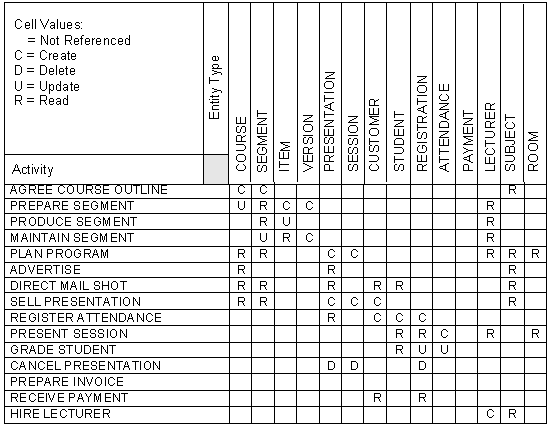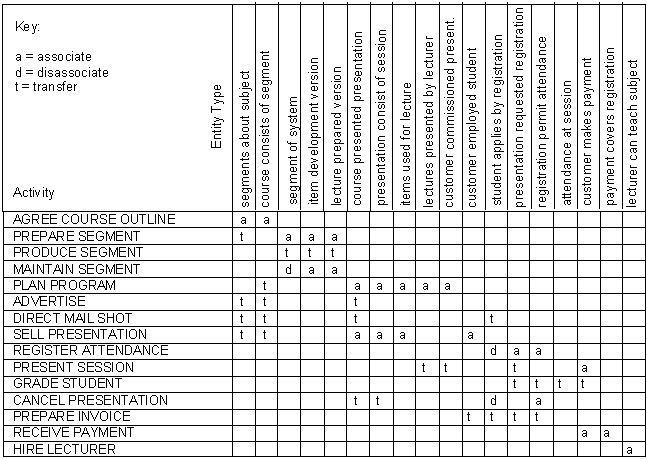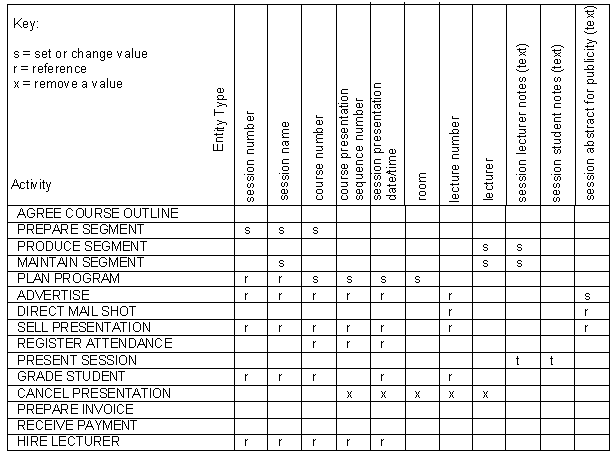

Confirming Analysis › Checking for Completeness › Interaction Cross-Checking
Interaction Cross-Checking
Interactions show how business activities use data analysis objects. They summarize the involvement of processes with entity types, attributes or relationships.
Three interaction checks can be developed, using:
- Elementary Process/Entity Type Matrix
- Elementary Process/Relationship Table
- Elementary Process/Attribute Table
An Elementary Process/Entity Type Matrix indicates whether every defined entity type is fully used. CA Gen can produce the Elementary Process/Entity Type Matrix, as described in the chapter titled "Analyzing Interactions."
The tables can be produced as needed using a spreadsheet or similar utility.
You perform these checks to determine whether the new business model contains a process to:
- Create, Read, Update, or Delete each entity type
- Associate and Disassociate each relationship
- Set values for attributes and to reference, change, or remove these values
The Elementary Process/Entity Type Matrix is useful throughout analysis. Relationships and attributes, however, are finalized later, through interaction analysis and checking against the findings of current systems analysis.
Using the Elementary Process/Entity Type Matrix
CA Gen automatically populates the Elementary Process/Entity Type Matrix with the list of elementary processes along one axis and entity types along the other.
Cell values are populated from the expected effects (Create, Delete, Update, Read) of the elementary process. They do not come from entity action statements in the Action Diagram.
A cell may contain one letter only and shows the highest value if more than one action is involved:
- Create takes precedence over Delete.
- Delete takes precedence over Update.
- Update takes precedence over Read.
Consider the following illustration:

This matrix reveals several problems within a current model:
- Two processes create the entity type version. It is worth examining whether the two processes should be combined.
- The entity type payment is not used. Either it is not required or the processes that use it are incorrectly defined.
- The process Prepare Invoice uses no entity types. According to the matrix, the process does nothing.
Using the Elementary Process/Relationship Matrix
- Each row in the matrix represents a process.
- Each column represents a relationship.
- A cell may contain only one letter. Letters indicate action types.
The following illustration shows an example of this type of matrix.

The example in the illustration raises several questions about the current model:
- The relationships presentation consists of session, and course presented as presentation, are associated in two processes Plan Program and Sell Presentation. This double association suggests potential duplication.
- The matrix shows transfers involved with many relationships in the model, whereas most relationships are, in fact, fixed. You must investigate this discrepancy.
Using the Elementary Process/Attribute Matrix
Each row represents a process, and each column represents an attribute. This matrix includes attributes from one entity type only. Letters in cells indicate action types.
Consider the following illustration.

The example in this illustration raises questions about the current model:
- The process Cancel Presentation removes the attribute Lecturer Number, but no value has been given to the attribute. It has not been set.
- The processes Agree on Course Outline, Present Session, Prepare Invoice, and Receive Payment use no attributes. Is this consistent with the Elementary Process/Entity Type Matrix? If so, what do the processes do?
Copyright © 2014 CA.
All rights reserved.
 
|
|




